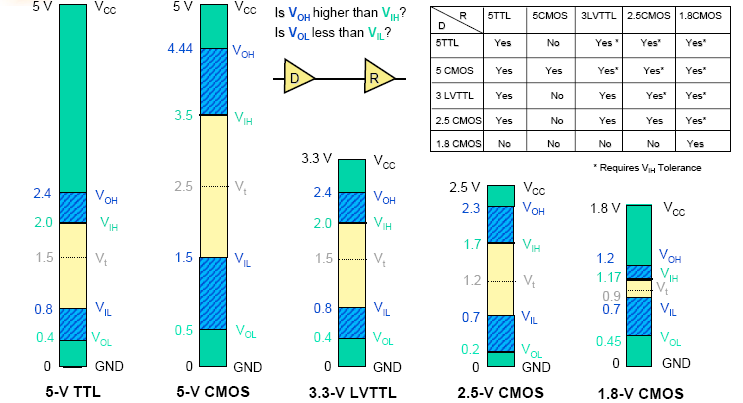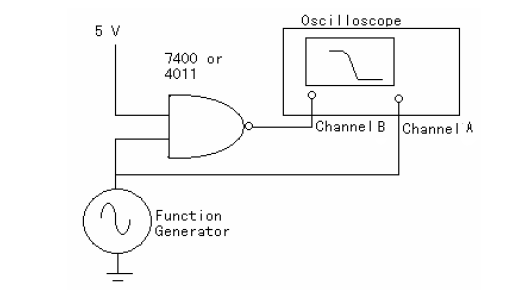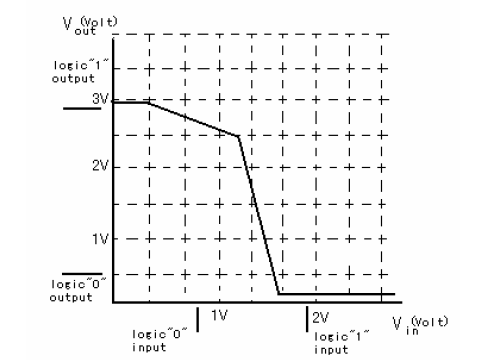PC/CP200 Electronics Lab I
Logic Gate Characteristics - Voltages, Propagation
Delay, and Temperature
Objectives
- To measure the voltage characteristics for various digital logic
families.
- To measure the propagation delay for various digital logic families.
- To obtain and interpret information from a data sheet.
Preparation
The operation of an ideal logic gate can be summarized by the
following rules:
- Input and output voltages will be at either the high or the
low value specified for that family; (e.g. 5 and 0 volts, respectively
for TTL).
- Inputs will draw no current from whatever drives them, and
outputs can supply as much current as necessary for whatever follows.
- Any change of an input will immediately be effected on the
output.
In practice, these rules do not hold. A real logic gate operates
under the following restrictions:
- Input voltages will not always be at their ideal values, and so
a range of input values must be considered high and another range of
input values must be considered low. Similarly output voltages will
not always be at their ideal values, and so a range of output voltages
should be considered as high, while another range of output voltages
should be considered low.
- Inputs must draw a small but finite amount of current from the driving
devices and outputs have a limited current capacity for maintaining
the output voltage at the desired level.
- Changes made at the inputs will take a finite amount of time to
be effected on the outputs.
Note that in most labs comparing “real" to “ideal" values
involves seeing how close one number, (the “real" value) is
to another (the “ideal" value). With digital logic chips, however,
rather than having a single “ideal” value for a parameter,
the manufacturers give parameter bounds. These specifications are not
values that should be matched, but rather they are values that should
be considered as limits during real operation. For instance, TTL logic
has a nominal input “high” voltage of 5 volts, but in practice
any voltage above 2.0 volts will be considered “high”. Normally,
voltage parameters will be different for input and output. For the same
TTL logic family, a "high" output will be any output voltage above 2.4
volts.
Note that for some parameters the specifications will give an upper
bound, for some they will give a lower bound, and for others they will
provide a range. Which one is given will make sense if you understand
what each parameter means.
Supply Voltages
Digital logic chips have a power pin(s) and a ground pin(s). These supply
voltages have names which are based on the type of transistors used in
the construction of that particular logic family.
- TTL gates are made with bipolar transistors, which have a collector
and an emitter; so the supply voltages are shown as VCC (power)
and Ground (occasionally shown as VEE)
on most data sheets.
- CMOS gates are built with field-effect transistors, which have a drain
and a source; so the supply voltages are shown as VDD (power)
and VSS (ground)
on most data sheets.
Voltage Characteristics
The voltage characteristics of a logic gate depend on the logic family
used to construct the device and are always specified on the device data
sheet. The voltage characteristics are always specified in terms of four
values:
- VIHmin --
the minimum input voltage which will be accepted as a logic 1 state.
- VILmax --
the maximum input voltage which will be accepted as a logic 0 state.
- VOHmin --
the minimum output voltage representing a logic 1 state.
- VOLmax --
the maximum output voltage representing a logic 0 state.
The following diagram shows these voltage characteristics for five types
of chips: two families (TTL and CMOS) with various supply voltage characteristics
(two high voltage and three low voltage variations). All properly operating
chips must work within these ranges. For example, if both inputs to a
7400 TTL NAND gate are greater than or equal to 2.0 volts, they will
be considered “high” and the output should be “low”,
i.e. at a voltage less than or equal to 0.4 volts. Notice that the output
range, either high or low, is always smaller than the input range.

Texas Instruments, Logic Selection Guide,
2003
For high voltage CMOS logic (second from left in above diagram), the
supply voltage VDD can
actually range from 3.5V to 15V. The diagram only shows the voltage characteristics
at a supply voltage of 5V to allow comparison to the 5V TTL characteristics.
Read the data sheet for voltage characteristics at supply voltage values
greater than 5V.
Propagation Delay
Ideally changes to the inputs of a gate would be effected at the output
immediately, but in reality there is a slight delay. In addition, the
delay may be different depending on whether the gate's output is going
from low to high or from high to low. Furthermore, the transitions themselves
are not instantaneous, so they are defined as being at the 50% point
of the voltage transitions. Thus there are two quantities of interest:
- tPLH --
the time interval between the change of an input and the resulting
change in output, when the output must change from low to high.
- tPHL --
the time interval between the change of an input and the resulting
change in output, when the output must change from high to low.
Note that in both cases above, the direction of the input transition
is immaterial.
Equipment
- bench power, variable power supply
- breadboard
- SN7400 (1) [1988 datasheet, 2003
datasheet]
- CD4011UB (2) [1998 datasheet, 2003
datasheet]
- signal/function generator - one of Wavetek 19, Wavetek 182A (do not
use an HP 3311A)
- oscilloscope - one of TDS 210, TDS 1002 (old and new numbers for
the same oscilloscope)
Procedure
| Great care should be taken to avoid static discharge
into CMOS (static sensitive) based chips. |
Before starting the lab, review the CMOS handling procedures.
- Always use a ground strap. If your grounding mat doesn't have two
grounding straps, one for each of the partners, see the lab instructor.
- CMOS devices should be stored pin down in conductive foam when they
are not in a circuit.
- Never leave unused inputs floating; connect to ground or +5V to
prevent excessive current consumption and erratic behaviour.
- Never connect an input signal to a CMOS device when the power is
off.
Voltage Characteristics
Do the following analysis first for the 7400 and
then repeat for the 4011. Before
starting, determine which of these chips is CMOS ?
- If using an analog scope, connect the equipment and the component
as shown below. If using a digital scope, connect the function
generator to channel 1 and the device to channel 2 (opposite of diagram).
Make sure both the function generator and the oscilloscope have the
same ground (oscilloscope ground not shown in diagram).

- For the function generator, select a 0 to 5V sine wave with a frequency
of 1 kHz. For the oscilloscope, select the X-Y mode of operation. A
trace similar to the one shown below should be obtained. This is called
the transfer characteristic of the gate. Note that the input
voltage, Vin, is on the X axis and the output voltage, Vout, on the
Y axis.

- Measure the values of the following parameters and compare your measurements
with the values given in the appropriate data sheet to see whether
the devices fit the manufacturer's specifications. Specifically, you
want to answer the following questions:
- What output voltage is produced by an input voltage of the specified
value of VILmax?
This would be the measured value of VOHmin.
Is it within the manufacturer's specifications?
- What output voltage is produced by an input voltage of the specified
value of VIHmin?
This would be the measured value of VOLmax.
Is it within the manufacturer's specifications?
Demonstrate and explain your measurement to lab staff.
Propagation Delay
- Using two 4011 chips, construct the circuit shown below. Use a chain
of 8 gates (n=8) to determine the propagation delay tP. In
order to obtain a good measurement of the delay time, a frequency of
operation should be chosen sufficiently high so that the total delay
in the chain (ntP)
is comparable to the period of the input clock. Obtain the delay times
tPHL and
tPLH from
the data sheets. Use the oscilloscope to measure Vin and Vout. Use
a square wave as input.
Why can we not measure both tPHL and
tPLH from
the circuit shown? [Hint: how many gates do we have and what is the
relationship between the input and the output?]

- The propagation delay of a CMOS gate is a function of the load capacitance
and the supply voltage VDD.
Determine the propagation delay tP as
a function of VDD.
Use a variable power supply and measure with VDD at
5V, 10V, and 15V.
When using different values for the supply voltage, be sure to adjust
the amplitude of the square wave input voltage appropriately. Remember
that the voltage required to obtain a "high" changes
as the supply voltage changes. The voltage diagram in this lab
(in preparation section) only shows the voltage characteristics at
a supply voltage of 5V to allow comparison to the 5V TTL characteristics.
Read the static electrical characteristics in the data sheet for voltage
characteristics at other supply voltage values. Note, these are
input voltages that can be read as exact values from the table; you
do not have to figure it out from the graphs.
Demonstrate and explain your measurement to lab staff.
- Plot a graph of propagation delay as a function of supply voltage,
labeling everything appropriately.
- How do your results compare to the device data sheet?
Temperature and Supply Voltage Characteristics
For both the 7400 and the 4011:
- What range of power supply voltages is allowed for normal operation
of the chip?
- What range of power supply voltages is guaranteed not to destroy
the chip?
- Over what range of temperatures may the chip be expected to operate
normally?
- Over what range of temperatures may the device be stored safely?





